‘That Zealous & Learned Prelate’
Published in Early Modern History (1500–1700), Features, Issue 2 (Summer 2002), Volume 10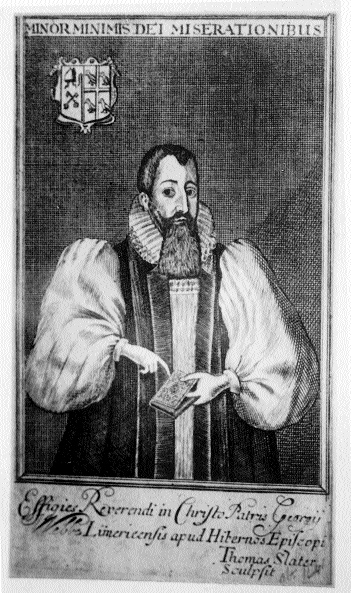
Portrait of Bishop George Webb of Limerick. (Keith Wiseman/St Mary’s Cathedral, Limerick)
At 11 o’clock on the morning of Thursday 23 June 1642 General Garrett Barry and other leading members of the Catholic army of Munster were admitted to the castle of Limerick. The ancient fort (known today as King John’s Castle) had been closely besieged for the past five weeks until the hungry and sick men of the garrison were compelled to surrender. The constable, Captain George Courtenay, stood weary but unbowed inside the gate, preparing to meet his adversaries to formally hand over the colours, yielding possession of the castle to the Irish rebels. The surviving Protestant men, women and children gathered up what little belongings they had and filed out of the courtyard to seek accommodation in the town. Under the articles of surrender they had been granted leave to depart in safety to Cork, though several weeks would pass before they were able to take ship and finally bid Limerick farewell.
One of the first duties that Captain Courtenay had to attend to was the burial of Dr George Webb, Bishop of Limerick. The bishop was the first important casualty of the outbreak of rebellion in Limerick in 1642, and one of more than 200 souls who perished in the castle since the beginning of the siege on 18 May. Many of the poorer sort became ill relatively soon, due to shortages of food and medicine, and were buried in mass graves dug in the courtyard, fifteen or sixteen individuals to a pit. A corner of the castle would have been the bishop’s last resting place as well, were it not for the fact that his death occurred on the afternoon of 22 June, the penultimate day of the siege, making it possible for his remains to be carried the next day to the grounds of the nearby St Munchin’s Church, where a proper, though hasty, burial took place.
Webb’s early career
The dreadful scenes stemming from the siege and the untimely manner of his death would not have been envisaged by George Webb when he first took up his new appointment soon after his consecration as bishop of Limerick at St Patrick’s Cathedral, Dublin, on 18 December 1634. He was born in 1581, the third son of Hugh Webb, rector of Bromham, Wiltshire, and entered New College, Oxford, in April 1598, transferring to Corpus Christi, Oxford, the following year. He was awarded the degree of Bachelor of Arts in February 1602, and Master of Arts in June 1605. Webb took holy orders and became vicar of Steeple-Ashton, Oxfordshire, on the recommendation of William Herbert, Earl of Pembroke. He kept a grammar school there and afterwards at Bath, where he became rector of the parish of St Peter and St Paul in July 1621. In 1622 he received a grant of the office of Keeper of St Mary Magdalen’s hospital near Bath, and in 1624 was made a Doctor of Divinity. When Charles I was crowned in 1625 he was appointed chaplain to the new king. Contemporaries considered him the best preacher at the royal court, and the ‘smoothest’ writer of sermons.
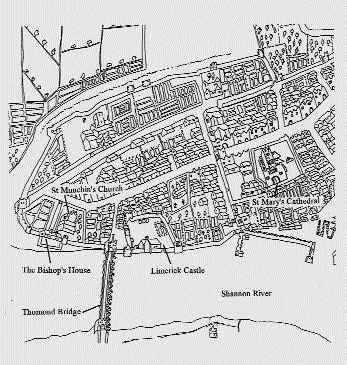
Detail from a map of Limerick c.1590, showing the location of the bishop’s house in relation to the castle and the cathedral. (Limerick Corporation)
He baptised the king’s first son on 13 May 1629, although the infant Charles James died shortly thereafter. The bill for the king’s signature containing the grant of the bishopric of Limerick to George Webb was ordered by William Laud, Archbishop of Canterbury, in September 1634. In a letter written a month later to Viscount Wentworth, Lord Deputy in Ireland, Laud states that the king himself had decided upon George Webb, ‘one of his ancient chaplains’ as the next bishop of Limerick. The appointment was a blow to the ambitions of the current Dean of Limerick, George Andrews, who despite pressing his claim with Laud, and enlisting the support of the Lords Justices in Ireland, was not able to compete with a man who had the backing of the king (the following year Andrews was compensated with promotion to the bishopric of Ferns and Leighlin). On being elevated to the see of Limerick, George Webb’s rectory at Bath was bestowed on his son, Theophilus.
Webb’s deep knowledge of and passion for the scriptures manifested itself in a productive literary output, although his publications all predate his advancement to Limerick. In 1609 he published God’s controversie with England: or, a description of the fearefull and lamentable estate which this land at present is in. This was based on a sermon preached on Trinity Sunday, and was the first of at least twelve sermons he published between 1609 and 1619. His most successful work was The practise of quietness, directing a Christian how to live quietly in this troublesome world. The seventh edition of this volume was published in London in 1638 and contained the bishop’s engraved likeness on the title page. The new bishop’s character as a contemplative preacher and devout Anglican faced a stiff challenge on his arrival in Limerick. He would have found his removal from the sheltered English pastures he had known all his life to the strange surroundings of a predominantly Catholic city in Ireland somewhat unsettling. But there is no doubt that he would have welcomed this development in his fortunes as a God-given mission, to which his natural instincts for proselytising would have responded with their accustomed vigour. Since 1593, when John Thornburgh, chaplain to Queen Elizabeth, was promoted to Bishop of Limerick, after it had remained vacant two years, the prevailing policy was to keep a worthy and reliable Englishman as bishop there, and Webb’s appointment was consistent with this. He was the fifth Protestant bishop of Limerick. His predecessor Francis Gough, like Webb a native of Wiltshire and Oxford-educated, was created bishop in 1626. The diocesan cathedral was the ancient foundation dedicated to St Mary, which occupied a prominent and central position within the city of Limerick.
Limerick in the 1630s
The Limerick that greeted Webb at the end of 1634 was a thriving, long-established urban centre which had remained loyal to the Crown throughout the wars of the latter part of the sixteenth century. Limerick’s steadfastness was acknowledged when James I issued a charter in March 1609, which granted full borough status to the city, extending the limits of urban jurisdiction by up to three miles. Preoccupation with defence was a fact of life in those days. The city was built on an island in the middle of the River Shannon and was strongly walled. Not only that, but a suburb known as Irish Town, which developed to the south, was itself enclosed by a wall, giving the city the appearance of two conjoined towns. With its lofty, square tower over the entrance, even St Mary’s Cathedral looked more like a fortification than a place of worship. The principal military building, a little to the north of the cathedral, was the king’s castle. This massive edifice, dating originally from the Anglo-Norman period, gave additional strength to the city wall close to Thomond Bridge, which connected Limerick with County Clare.
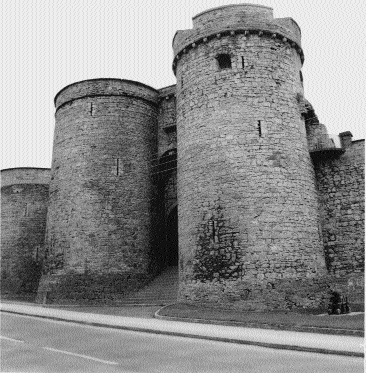
The main gate of Limerick castle (‘King John’s Castle’), fortified by two powerful flanking towers. The body of George Webb was carried through this portal on Thursday 23 June 1642 and taken for burial in the nearby graveyard of St Munchin’s Church. (Dermot Hurley/Shannon Development)
The castle’s main artillery platform, constructed as recently as 1611, was directed towards the interior of the city, suggesting that despite appreciating Limerick’s loyalty thus far, the authorities viewed attack from the citizens themselves to be the main risk to the castle’s security. These fears were fully justified, as George Webb was to discover to his cost. Webb would have been impressed and reassured by the forbidding strength of the castle’s exterior, but it was its interior that was to provide him with his final view of the world.
Relations with the Catholic oligarchy
Among the concerns for the bishop would have been the small size of the Protestant community in Limerick, and the fact that the city was run by a network of weathy merchant families—the Arthurs, Whites, Creaghs, Roches and so on—who almost without exception continued to embrace the Catholic faith. The widespread local tolerance and practice of Catholicism was a matter that would have vexed him, but the need to maintain good relations with the dominant Catholic elite meant that he had to temper his personal persuasions with restraint and pragmatism. The principal municipal offices, the mayor, recorder and two sheriffs, were supposed to be occupied by Protestants, and during the reign of James, efforts were made to ensure that Catholics were excluded from holding these magistracies. However, with the succession of Charles in 1625, tough measures against Catholics were relaxed, and the position of mayor was routinely filled by a practising Catholic, an indulgence which was ultimately to lead to calamity when Dominick Fanning, elected mayor in 1641, invited the Catholic army commanded by General Barry to occupy the city at the end of April 1642. During Webb’s time in Limerick, all the mayors were appointed from within the Catholic coterie, with a single exception in 1638 when Robert Lillies held the office. In 1642 Lillies joined Bishop Webb and hundreds of other Protestants in the protective confines of the castle, and he was involved in negotiating terms of surrender prior to the conclusion of the siege.
We have knowledge of at least one instance where George Webb tangled with the Catholic oligarchy at Limerick. The matter in question came to a head in 1637 when the merchant John Arthur was censured for defaming the bishop. The details of what exactly provoked the incident are not recorded, but we know that Arthur appeared before Webb when the bishop was sitting on the consistory court, and unleashed a torrent of verbal abuse (‘uncivill and irreverent speeches’), rounding on him for his lack of ‘law, honestie and conscience’ in a manner that was to ‘the great impayringe and blemisheinge of the creditt and integritie’ of the bishop. The case illustrates the underlying social and religious tensions in Limerick, and the latent capacity for hostility that was to manifest itself in outright insurrection less than five years later.
George Webb’s time in Limerick seems to have been very largely concerned with increasing revenues from the considerable lands that were theoretically in church ownership in the diocese, but which over the years were progressively passing into private hands and were generating less and less income for the bishop. He compiled an account of rents of the church property in the diocese in 1641, which shows another side to the man. The sermonising preacher with his mind attuned to redemption and spiritual deliverance had a taste for more wordly business, and a steely resolve to make the diocese pay its way, no matter how much tedious effort was involved.
Tenants ‘are growne mutinous and prone to rebellion’
Webb’s rental book illustrates the many frustrations he encountered in attempting to reform the revenues of the diocese. His accounts are particularly revealing about the state of affairs at Kilmallock. He sued for recovery of ten ploughlands (1,200 acres of arable land), and although the rents were restored, the amount received was only a fraction of what Webb felt the lands to be worth. When first appointed bishop he leased lands to a Protestant named Nicholas Faunt, whose promises to develop them were not carried out. The bishop received no rent from twenty houses near the quarry outside Kilmallock which were his property. He claims that nine mills were held against him, and the tenants ‘are growne mutinous and prone to rebellion’. Although the bishop was entitled to royalties and any penalties levied in the courts at Kilmallock, it was impossible for him to collect any of this money, due to what he describes as ‘the barbarous tyrranie of that incorporation, who will not suffer anie English to dwell near them’. An officer sent by Bernard Adams, Bishop of Limerick between 1604 and 1626, had his ‘braines beaten forth’ and another man was killed along with his family when their house was burned down. Webb’s comments clearly reveal deep-rooted resentment and disquiet at Kilmallock, a groundswell of discontent between native Irish and New English, which provides the backdrop to the easy fall of the town to the Catholic army in 1642.
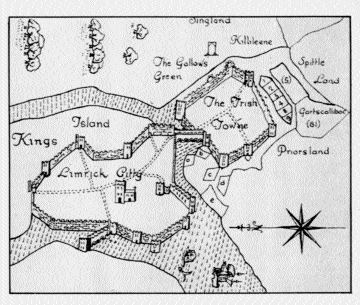
A mid-seventeenth-century map of Limerick. The walled city, with St Mary’s Cathedral in the centre, was built on an island in the the River Shannon and protected on the Munster side by a walled suburb (the ‘Irish Towne’) of similar size. (Old Limerick Journal)
His problems with Nicholas Faunt show that it was not just with the Irish that George Webb had difficulties over rents and contentious land holdings. Protestants and English settlers also encroached on land that he would have considered rightfully part of the episcopal assets. One particularly important Protestant landowner that Webb had on his mind ironically enough was George Courtenay, who was to command the garrison for the duration of the siege of Limerick Castle. In connection with lands at Cloncrough, Courtenay refused to pay rent to the bishop, claiming that he was paying rent to the king for the land. Courtenay was in arrears for land at Cloneltie, and he was also required to ‘doe suit and service’ at the bishop’s court at Clonshare four times a year, but was neglecting to do so. Furthermore, the patronage of the rectory and vicarage of Mahownah, which was given to the bishopric following the attainder of the fourteenth Earl of Desmond in 1582, was now ‘usurped upon’ by George Courtenay, along with the patronage of the prebend and vicarage of Croagh. We can probably safely assume that during the course of the siege of Limerick Castle in May and June 1642, Bishop Webb most likely did not remind Courtenay of these delicate matters of debt and irregularity!
1641 Rebellion
When the waves of rebellion in Ulster of October 1641 spread to Munster by the end of the year, distressed Protestants came in numbers to Limerick for protection. The security of the city was bound to be a concern, given the overwhelming size of the Catholic population. The president of Munster, Sir William St Leger, was compelled to turn his back on Limerick because of disturbances in Tipperary, and he pulled out all the troops stationed there, trusting (in vain, as it turned out) that Mayor Dominick Fanning would protect the English interests and remain faithful. George Webb was very much on the alert for signs of potential trouble well in advance of 1641. His contemporary, Dr Henry Jones, writing in 1642 on the outbreak of the troubles, referred to him as ‘that zealous and learned prelate’, and noted that prior to the insurrection the bishop seized a seditious book in Limerick concerning the friars of the Augustine order.
Webb offered to assist the constable Captain George Courtenay in improving the defences of the castle in preparation for the siege. There were no carriages of sufficient height for the guns on the platforms. Webb saw that these were provided, although this must have been Courtenay’s responsibility. He continued to preach for as long as possible before the siege was imposed. It is recorded that he kept a fast every Wednesday, no doubt hoping that such religious dedication would bring about some deliverance for the Protestants of Limerick from what was rapidly becoming their darkest hour. The bishop’s residence occupied an unusual location on the external side of the city wall a short distance to the north of Thomond Bridge, adjacent to the grounds of St Munchin’s Church. Before he retired to the castle he left a ward in the house, in a completely futile effort to keep the property protected during his absence.
As the siege progressed Webb must have been particularly galled by the fact that Irish musketeers occupied St Mary’s Cathedral, ran up a rebel flag, and proceeded to fire into the yard of the castle, claiming the lives of a few of those sheltering there. His house was one of a number of other buildings that were occupied by Irish troops, and gunfire was directed at the castle from it on 13 June. Food, fuel and medicine began to run out rapidly for the besieged, with tragic consequences. George Webb himself became unwell with dysentery, and by 21 June, just two days before the siege ended, it was clear to George Courtenay that the bishop was nearing the point of death. By this stage the bastion and eastern wall of the castle were heavily undermined, and Courtenay was anxious to agree terms with the Irish army council, and to make arrangements for the burial of the bishop.
On the afternoon of 22 June, Bishop Webb passed away. Following the surrender of the castle the next day, his body was carried through the main gate and taken for burial to the graveyard of St Munchin’s Church. As Bishop of Limerick, his remains should by right have been interred in St Mary’s Cathedral, a dignity accorded his predecessors. But it is clear that while the leaders of the Irish army were prepared to respect the body of the bishop, they stopped short of honouring the deceased with a place in a hallowed building that Limerick’s Catholics were anxious to reclaim as their own (four years later, the death of the Catholic Bishop of Limerick, Richard Arthur, was followed by a full ceremonial burial in the cathedral, with the papal nuncio, Rinuccini, in attendance).
Tales of his exhumation and mutilation
Sources relate that within a few days of burial Bishop Webb’s body was exhumed, stripped, mutilated and reburied with a dead dog. Canon John Begley considered the story to be ‘extremely unlikely’, as there were no ‘revolting outrages’ committed in Limerick at this time. The incident was related directly to the historian Anthony à Wood by one of Webb’s sons, and as described by him, the body was searched by individuals looking for rings ‘or other choice things’ and then ‘reposed’ in the same place. The moderate tone of Wood’s version would suggest that the body was indeed exhumed for a short time and reburied, but the shocking tales of mutilation mentioned elsewhere are most likely untrue.
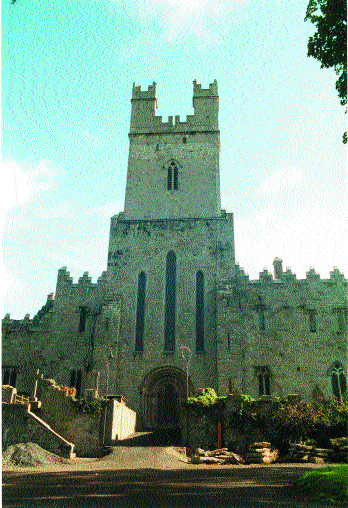
View of the western elevation of St Mary’s Cathedral, Limerick. The characteristic bell tower directly over the main entrance provided a commanding view of the courtyard of the castle to the north and was occupied by musketeers during the siege of 1642. (Ken Wiggins)
Subsequent to the capture of the king’s castle the city of Limerick remained in Irish hands for nine years, a historic period of independence brought to an end by the parliamentarian army led by Lt-General Henry Ireton, who received the keys to the city on 29 October 1651 following a long, exhausing siege. Ireton established a court martial in St Mary’s Cathedral, the place where George Webb preached so often during his episcopacy. Several of those responsible for the city’s stubborn resistance were sentenced to death, and among them was the former mayor Dominick Fanning, whose subversive initiative in 1642 made the siege of the castle possible. If he had lived to witness the execution of Limerick’s Catholic leaders in November 1651, what would have gone through George Webb’s mind? It was one thing Ireton dealing justice to the captured Irish, but nearly three years earlier Cromwell’s son-in-law was party to the infamous execution of King Charles, the sovereign to whom Webb was a devoted servant. It is a matter of conjecture which insult would have offended George Webb most: the triumph of the Irish rebels in 1642, or the ultimate victory of the regicide Ireton in 1651.
Ken Wiggins is a consultant archaeologist based in County Limerick.
Further reading:
J. Begley, The diocese of Limerick in the 16th and 17th centuries (Dublin 1927).
K. Wiggins, Anatomy of a siege: King John’s Castle, Limerick, 1642 (Bray 2000).
A. à Wood, Athenae Oxonienses, vol. 1 (London 1691).
















